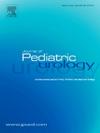The effect of preoperative ureteral stenting on the outcomes and complications of pediatric ureteroscopy: A systematic review and meta-analysis
IF 1.9
3区 医学
Q2 PEDIATRICS
引用次数: 0
Abstract
Introduction
Small ureteral caliber may prohibit safe primary ureteroscopy (URS), particularly in children. Pre-stenting was proposed to passively dilate the ureter for later safer ureteral access. This meta-analysis aims to analyze outcomes of both primary and deferred ureteroscopy after a period of pre-stenting.
Methods
PubMed, Scopus, Cochrane Library, and Web of Science were searched for studies comparing outcomes of primary and deferred ureteroscopy in children younger than 18 years with ureteral and/or renal stones. Outcomes of interest were stone free rate (SFR), complication rates, ureteral injury, urinary tract infection (UTI), operative time, stone migration, postoperative stenting use and ureteral access sheath use.
Results
Four studies encompassing 826 patients were included. When attempted, primary ureteroscopic access was successful in 69–83 % of patients. SFR was higher in the pre-stenting group (OR 0.87, 95 % CI [0.81–0.94], P = 0.0005). No significant difference was found between the two groups in terms of the overall complications rate (RR 1.66, 95 % CI [0.93–2.96], P = 0.09), ureteral injury (RR 3.67, 95 % CI [0.43–31.66], P = 0.24) febrile UTI (RR 0.62 (95 % CI [0.15 to 2.5], P = 0.5), use of postoperative stent (OR 0.86, 95 % CI [0.52–1.44], P = 0.58), use of ureteral access sheath (RR 0.94 (95 % CI [0.73 to 1.22], P = 0.65), or stone migration (RR 2.28 (95 % CI [0.48 to 10.80], P = 0.30).
Conclusion
Although pre-stenting is associated with a relatively higher SFR, primary URS is successful in most pediatric patients without increased complication risk. We advocate primary URS whenever possible to allow stone treatment under a single anesthetic and minimize healthcare costs.
术前输尿管支架置入对儿童输尿管镜检查结果和并发症的影响:一项系统回顾和荟萃分析。
导读:输尿管小口径可能会妨碍安全的原发性输尿管镜检查,尤其是儿童输尿管小口径。建议预先支架置入,以被动扩张输尿管,以便以后更安全的输尿管通路。本荟萃分析旨在分析原发性输尿管镜检查和延期输尿管镜检查在预支架置入一段时间后的结果。方法:检索PubMed、Scopus、Cochrane图书馆和Web of Science,比较18岁以下儿童输尿管结石和/或肾结石的原发性输尿管镜检查和延期输尿管镜检查的结果。我们关注的结果是结石清除率(SFR)、并发症发生率、输尿管损伤、尿路感染(UTI)、手术时间、结石迁移、术后支架植入和输尿管通路鞘使用。结果:纳入4项研究,共826例患者。当尝试输尿管镜时,69- 83%的患者成功进入输尿管镜。支架置入术前组SFR较高(OR 0.87, 95% CI [0.81-0.94], P = 0.0005)。两组之间没有显著差异被发现的并发症率(相对危险度1.66,95%可信区间(0.93 - -2.96),P = 0.09),输尿管损伤(相对危险度3.67,95%可信区间(0.43 - -31.66),P = 0.24)发热性泌尿道感染(RR 0.62(95%可信区间(0.15到2.5),P = 0.5),使用术后支架(或0.86,95%可信区间(0.52 - -1.44),P = 0.58),使用输尿管访问鞘(RR 0.94(95%可信区间(0.73到1.22),P = 0.65),或石头迁移(RR 2.28(95%可信区间(0.48到10.80),P = 0.30)。结论:虽然支架置入术与较高的SFR相关,但在大多数儿科患者中,原发性URS是成功的,没有增加并发症的风险。我们提倡在可能的情况下使用单一麻醉剂治疗结石,并尽量减少医疗费用。
本文章由计算机程序翻译,如有差异,请以英文原文为准。
求助全文
约1分钟内获得全文
求助全文
来源期刊

Journal of Pediatric Urology
PEDIATRICS-UROLOGY & NEPHROLOGY
CiteScore
3.70
自引率
15.00%
发文量
330
审稿时长
4-8 weeks
期刊介绍:
The Journal of Pediatric Urology publishes submitted research and clinical articles relating to Pediatric Urology which have been accepted after adequate peer review.
It publishes regular articles that have been submitted after invitation, that cover the curriculum of Pediatric Urology, and enable trainee surgeons to attain theoretical competence of the sub-specialty.
It publishes regular reviews of pediatric urological articles appearing in other journals.
It publishes invited review articles by recognised experts on modern or controversial aspects of the sub-specialty.
It enables any affiliated society to advertise society events or information in the journal without charge and will publish abstracts of papers to be read at society meetings.
 求助内容:
求助内容: 应助结果提醒方式:
应助结果提醒方式:


